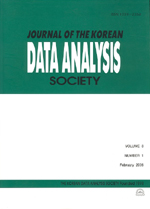역통계량을 이용한 강수량자료의 공간예측
Spatial Prediction of Daily Precipitation Data Based on Inverse Statistics
- 한국자료분석학회
- Journal of The Korean Data Analysis Society (JKDAS)
- Vol.18 No.6
-
2016.123011 - 3021 (11 pages)
- 4

시계열자료의 변동성에 따른 특정 사건의 발생시간을 추정할 수 있는 역통계량(inverse statistics)은 첫 통과시간(first passage time)과 매우 밀접한 관계를 가진다. 첫 통과시간이란 특정한 기준값을 설정하여 그 기준값을 넘는 인접한 사건 사이의 시간 간격(time difference)으로 정의한다. 일일 강수량 자료의 경우 특정 기준값보다 더 많은 강수를 기록한 날 사이의 간격으로 강수량의 첫 통과시간을 계산하고, 역통계량을 활용한 분석을 실시할 수 있다. 이를 통해 특정 강수 이상의 사건이 발생할 때까지의 시간 간격을 예측할 수 있다. 또한, 일일 강수량 자료는 일반적으로 관측자료 뿐만 아니라 고정된 관측지점의 위치정보 포함하고 있는 지리통계학적 공간자료(geo-statistical data)이다. 따라서 강수량 관측자료와 고정된 위치자료를 활용하여 공간통계기법을 적용할 수 있다. 본 연구에서는 기존의 역통계량을 활용한 분석방법과 공간통계기법을 결합하여 미지의 관측지점에서의 특정 강수 이상이 발생할 시간 간격을 예측하고자 한다. 실증연구에서는 한반도의 일일 강수량의 첫 통과시간을 분석을 실시하였고, 예측된 값을 이용하여 예측지도를 작성하여 한반도의 강수특성을 확인하였다.
In the inverse statistics, a dependent variable means times and independent variables are considered time series volatility. Therefore, the inverse statistics are closely associated with the first passage time. In case of precipitation data, we define the first passage time of daily rainfall data through setting the specific rainfall value. Suppose that if the rainfall data is r(t) at time t and r(t) over the specific value rho are measured at times t_1 and t_2, then the first passage time is defined as the interval between t_1 and t_2. Hence, we predict the lead time to over the specific amount of rainfall by using the inverse statistics method. Since the precipitation data are generally geo-statistical spatial data where location information of monitoring stations are included, we can apply spatial statistics in order to produce the spatial prediction at any arbitrary locations. In this paper, we employ the inverse statistics and spatial statistics for the first passage time data from daily rainfall data. Through the approach, we construct the prediction maps for finding characteristics of rainfall in South Korea.
1. 서론
2. 역통계와 공간상관성
3. 실증연구
4. 결론 및 논의
References
(0)
(0)